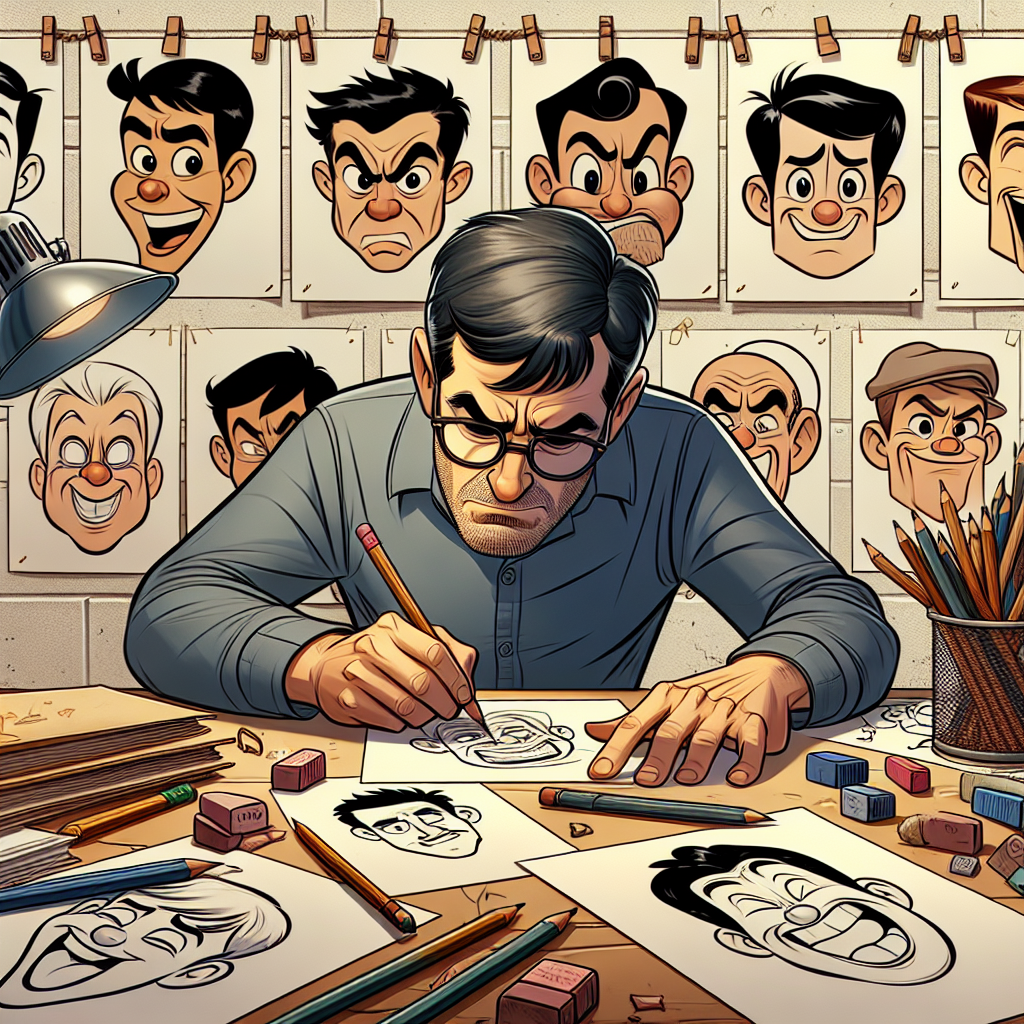Have you ever watched your favorite animated series and marveled at how much personality can be conveyed through just a simple face? The magic of cartoon illustration lies in the artist’s ability to capture emotions, quirks, and unique traits, all while keeping things playful and light-hearted. Whether you’re a seasoned illustrator or just dipping your toes into the world of cartoon art, mastering the art of cartoon faces can transform your creations from cute to characterful. So, grab your sketchbook, and let’s dive into the colorful world of cartoon faces!
The Importance of Faces in Cartooning
Faces are the windows to emotions. They are the first thing we notice in a character, and they play a crucial role in storytelling. A character’s face can express a range of feelings—from joy and sadness to surprise and anger. In the realm of cartooning, this expressiveness can be exaggerated to create stronger connections with the audience. Understanding how to draw faces that resonate can elevate your cartooning game significantly.
Understanding Facial Features
To effectively illustrate cartoon faces, you first need to understand the basics of facial features. Everyone’s face is unique, and capturing that uniqueness is key to creating memorable characters. Let’s break it down:
Eyes, the Soul of the Character
In cartooning, the eyes can be the most defining feature. They can be large and expressive or small and mischievous, depending on the character’s personality. Experiment with various styles of eyes—from big and round to narrow and slanted. Remember, eyes convey a lot of emotion, so play around with the shape and the direction they look to communicate feelings effectively.
The Nose: A Touch of Character
Nose shapes can hugely affect how a character is perceived. A tiny button nose might denote cuteness, while a big, bulbous nose can hint at a comical nature. Don’t be afraid to exaggerate the size and shape of the nose to fit your character’s persona. Try creating different nose types for various characters to see how it alters their overall vibe!
Mouths: The Key to Expression
The mouth is another powerful tool in your arsenal as a cartoon artist. It’s the gateway to portraying speech, laughter, and expression. Play with different mouth shapes—smirks, frowns, wide-open smiles—all can add a layer of depth to your characters. Notice how a simple change can give a whole new feeling to the same character!
Character Design: Building Unique Faces
When it comes to creating cartoon faces, each character should have some level of uniqueness. Here’s how you can do that:
Establish Character Traits
Before you sketch, think about who your character is. Are they a heroic figure, a mischievous sidekick, or a shy introvert? Defining these traits will guide your drawing choices. For example, a heroic character might have bold features and a strong jawline, while a timid character could have softer lines and rounded edges.
Experiment with Proportions
Cartoons thrive on exaggeration. Playing with proportions can help you achieve a distinctive style. Try elongating or shrinking certain features; perhaps give one character an oversized head with a tiny body for a more comical effect. Finding your unique style will set your work apart and make it instantly recognizable!
Stylization: Finding Your Artistic Voice
Your style is your signature! To develop a unique look for your cartoon faces, consider these tips:
Look to Inspirations
Study the work of other cartoon illustrators. Observe how they design faces and what makes their characters stand out. This doesn’t mean you need to copy their style, but seeing what you like can spark your creativity. Make an inspiration board of characters you admire.
Play with Colors
Color can evoke emotions, so don’t hesitate to experiment with palettes. Bright and bold colors might suggest fun and whimsy, whereas muted tones may imply seriousness or melancholy. Create a color chart that suits the personality of your characters and refer back to it as you illustrate.
Expression Exploration: Bringing Faces to Life
Once you’ve nailed the basic design elements, it’s time to bring your cartoon faces to life through expressions!
Study Real Emotions
People wear their emotions in their faces, so observe them closely. Watch how smiles change the face, how a frown might deepen a character’s lines, or how eyebrows shift to suggest anger or surprise. This understanding will help you translate human emotions into your cartoon style.
Practice Makes Perfect
Keep a sketch journal where you practice different expressions. Challenge yourself to draw the same character showing a range of emotions: happiness, sadness, anger, confusion. This exercise not only strengthens your understanding of emotions but also helps you build your character’s personality through their facial expressions.
The Role of Details in Cartoon Faces
Remember that details, while sometimes subtle, play a crucial role in characterization. Here’s how to effectively use details in your cartoon faces:
Add Unique Traits
Think of distinctive features that can help make your characters memorable. Freckles, scars, or unique hairstyles can all contribute to a character’s identity. These details can make them relatable and send visual cues about their personality or backstory.
Don’t Forget the Hair!
Hair can significantly influence how a character is perceived. Is your character stylish with spiky hair, or maybe they’re a wild, messy-haired genius? The hairstyle should align with their overall look. Remember, hair can also be used to express movement and emotion—like being blown back when a character is surprised!
Tools of the Trade: What You’ll Need for Cartoon Illustration
When embarking on your cartoon illustration journey, having the right tools can make all the difference. Here’s a quick rundown of what you might need:
Digital vs. Traditional
Choose between digital or traditional mediums based on your preference. Each has its advantages. Digital illustration offers more versatility with tools, editing options, and allows for easy adjustments, while traditional media (like pencils, pens, and markers) offers a tangible feel. Both paths can yield fantastic results!
Sketchbooks and Pens
Who doesn’t love a good sketchbook? Invest in one that inspires you, and keep it handy for jotting down ideas and practicing faces. Quality pens, especially fine-liners, will help you achieve clean lines that are essential in cartooning.
Creating Dynamic Poses with Facial Expressions
Now that you’ve got the fundamentals of cartoon faces down, let’s explore how to pair them with dynamic poses!
Body Language Matters
Facial expressions and body language go hand in hand. A character’s body positioning can amplify what’s going on in their face. For instance, crossed arms combined with a frown may suggest defensiveness or irritation, while jumping with a wide smile can denote joy and excitement. Always think about the full character when illustrating!
Sketching Action Lines
Use action lines to assess movement. These invisible guides can help you understand how to draw characters in motion while still capturing their facial expressions. They will serve as a guide to create fluidity and life, pulling your cartoon faces from static to lively!
Feedback and Growth: The Importance of Constructive Critique
No artist is an island! Seeking feedback is an essential part of the growth process.
Find Your Community
Join online forums, local art groups, or social media communities where you can share your work and receive feedback. Constructive criticism helps you see your work from different perspectives and can lead to significant improvements.
Reflect on Critique
When receiving critiques, keep an open mind. Sometimes the best insights come from unexpected places. Use this feedback to refine your style and try new techniques.
Final Thoughts: Your Cartoon Journey Awaits
Cartoon illustration is a delightful and rewarding journey that allows you to bring your whimsical ideas to life. As you practice drawing faces, remember that there’s no right or wrong way—just your unique interpretation of emotions and characters! Keep experimenting, stay curious, and let your creativity shine. Soon enough, you’ll find yourself not just mastering cartoon faces but also falling in love with every whimsical line you draw. Happy illustrating!
Frequently Asked Questions
What are the common styles of cartoon faces I should consider?
There are various styles of cartoon faces, including exaggerated, minimalist, and chibi. Each style has its nuances and can convey different emotions and tones. Exaggerated styles often emphasize certain features for comedic effect, while minimalist designs can create a clean and modern look.
How can I improve my cartoon face drawing skills?
Improving cartoon face drawing skills requires ongoing practice and study. Regularly sketch faces, explore different expressions, and study the work of other artists to inspire your style. Consider setting aside dedicated time each week for practice.
Are there any specific exercises to enhance my understanding of facial expressions?
Yes! A great exercise is to choose a single character and depict them demonstrating various emotions—happiness, sadness, surprise, anger, etc. This can help you understand how minor adjustments in features can lead to significant changes in expression.
Can I use digital tools for cartoon illustration, and what are the benefits?
Absolutely! Digital tools such as drawing tablets and software like Adobe Illustrator and Procreate offer great versatility and convenience. They allow for easy experimentation, quick edits, and the ability to work in layers, making the design process more efficient.
How can I make my cartoon characters more relatable?
To make your characters more relatable, focus on developing distinctive traits, backstories, and emotions that people can identify with. Adding familiar quirks or circumstances can help audiences connect with your characters on a personal level.








+ There are no comments
Add yours